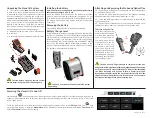
Changing strings
The outdoor guitar is equipped with special locking tuners to keep the
strings from coming off the tuner posts when removing the neck and to
keep the strings in their original tune.
To remove a broken string, loosen the locking nut on the tuner post with
a coin and pull the string out. To change unbroken strings you must
loosen them with the tuner button first, before you will be able to loosen
the tuner post. Loosen the tuner post by turning it against the string
tension. (different on left and right side)
To put the new string on, first pull the string through the string bar of the
bridge (when the guitar is assembled) and then pull it through the tuner
post until there is no more slack. Turn the tuner button as you would for
for normal tuning and it will automatically lock the string. After the string
is tuned, cut off the extra bit.
Retightening of the locking nut with a coin is not necessary as this
could possibly cause the string to break again!
Tunings and string gauges
The outdoor guitar is built for standard E tuning, but can also be tuned as high as G. Tuned to E (first and sixth string) the guitar is very easy to play
because of looser string tension due to the shorter scale (like the third fret on a 650mm scale length). To compensate for the looser tension we recommend
using a set of “medium” strings (013 / 056). Tuned to F# or G the guitar brings out its full volume and power, because the strings are set to their proper
tension. If you wish to tune it higher constantly we highly recommend using a lighter set of strings (012 / 054) as the OG is not built for such constant high
tension.
Different tunings, so called “open tunings”, are no problem. Avoid tuning your OG higher than the G tuning.
Storage
Try to keep your guitar in a humidity range between 40-60% (normal) and
avoid extremes. To be out of this range is not a problem if it is not for
weeks at a time.
We recommend keeping the OG disassembled and stored in the bag if it
won't be played for a few days. In the bag, the guitar is better protected
from temperature and humidity changes. It is also better for the top and
neck not to be under constant tension as it might change the “action”
(distance between fretboard and strings) after some time (also see
“adjusting the action”).
To put it away for a while without taking it apart you can lay it back into its
opend backpack. The open lit also serves as a neck rest. Underneeth the
neck insert there is room for thin notebooks. On the ouside there are
three compartment offering room some small and bigger items.
Adjusting the “action”
Your OG’s top is made of solid wood, meaning you might notice slight
changes with the "action" (distance between fingerboard and strings) if
you are travelling in different climates. The laminated body should not
be reacting much to those humidity changes. To prevent unwanted
changes, keep your guitar disassembled and stored in the bag if it won't
be played for a few days. The guitar is better-protected from temperature
and humidity changes in the case.
Just in case the neck bows up after some time, the steel-string OG has a
one way adjustable trussrod for neck correction. If you push down a
string on the 14
th
fret, there should be a gap of the thickness of a credit
card (0,5mm) at the 5
th
fret between the fret and the string. If the action is
much higher or the neck is too straight, follow the suggestions on the
right.
"action" too low:
Usually this means that the air is too dry (for example during winter). If your
guitar is exposed to less than 40% humidity for a few weeks, the neck and the
top might straighten out too much and the strings may start buzzing on the
fingerboard. If this happens, check first the neck’s curvature as mentioned
before. If the neck is too straight, loosen the trussrod until it looks fine.
Should this not be possible anymore, start tuning your guitar up to "G" to get
more tension on the neck or use a heavier set of strings. If the action does not
normalize after you are back in a "normal" climate, please contact Brunner
Guitars, so we can give you the appropriate advice.
"action" too high:
If your guitar becomes harder to play, this could mean that the action is too
high. Also in this case, first check the neck’s curvature as mentioned before.
Basically the opposite has happened to that described above. If the wood
expands because of too high humidity (60% and more), the top will warp up a
little and the neck may also curve too much. Both will cause the strings to
move further away from the fingerboard. If the neck’s curvature is too severe,
tighten the trussrod to its proper set-up. Is this not sufficient, then don't tune
your guitar higher than "E" or use a lighter set of strings. Again, if the action
does not normalize after returning to the "normal" climate, please feel free to
contact us for further advice. Overtightening the trussrod can cause serious
damage to your neck and void your warranty. Please don't try to do any major
repairs on your own! Serious neck problems are covered under warranty if you
refer the problem to us.
warranty
You have a three year warranty on your OG basic model covering any construction problems or material defects (shipping costs not included). Not covered
are any damages caused by improper handling or unauthorized repairs!
If you have any questions or a problem, don't hesitate to contact Brunner Guitars at [email protected] or call us at ++41 (0)81 862 20 89




















